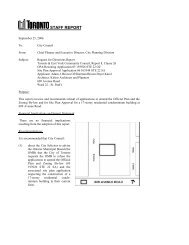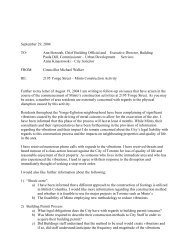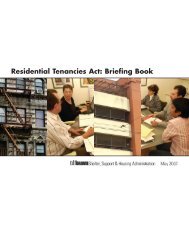Residential Tenancy Reform Consultation Paper
Residential Tenancy Reform Consultation Paper - Michael Walker
Residential Tenancy Reform Consultation Paper - Michael Walker
You also want an ePaper? Increase the reach of your titles
YUMPU automatically turns print PDFs into web optimized ePapers that Google loves.
Rents for new tenants<br />
RESIDENTIAL TENANCY REFORM CONSULTATION PAPER<br />
Under the current system, introduced by the Tenant<br />
Protection Act, 1997 (TPA), most rent increases are<br />
limited by the annual rent increase guideline. However,<br />
when a rental unit becomes vacant, there is no limit to the<br />
amount of rent that can be charged to the new tenant.<br />
This is commonly referred to as “vacancy decontrol.” When<br />
a tenant moves, he/she must choose from among vacant<br />
units that are “decontrolled” and which may be renting<br />
for considerably more than the tenant’s existing unit.<br />
Background:<br />
The current system of vacancy decontrol allows the market<br />
to determine the rent for vacant units. It has been argued<br />
that:<br />
a) this gives greater incentives for landlords to do capital<br />
work (such as major renovations and repairs) once a<br />
tenant moves out of a unit; and,<br />
b) it results in higher returns to investors in rental housing,<br />
who are then more likely to build new rental properties.<br />
However, it is also argued that vacancy decontrol creates<br />
an incentive for landlords to evict so that they can raise<br />
rents for the unit. As well, tenant advocates believe that<br />
vacancy decontrol has allowed rents to rise too quickly,<br />
resulting in an affordability problem.<br />
The government proposes to eliminate vacancy decontrol<br />
and introduce a system to regulate the rents for new<br />
tenants. At the same time, in order to retain incentives for<br />
investors to build more rental housing, the government<br />
proposes to decontrol regions where high vacancy rates<br />
provide a natural protection against large rent increases<br />
(see chapter on Regional decontrol.)<br />
Questions for consideration:<br />
1. By how much, if at all, should a landlord be able<br />
to increase the rent when a new tenant moves in?<br />
A. No increase. A new tenant should be charged the<br />
same amount as the previous tenant.<br />
This option would address the concern that vacancy<br />
decontrol encourages landlords to evict existing tenants in<br />
order to raise rents. It would also help keep rents on<br />
vacant units affordable. In the short run, this option may<br />
not have a large impact, since in many areas of the<br />
province, rent increases have been low in recent years.<br />
However, this is not the case in all communities.<br />
Further, this option might prove difficult for landlords who<br />
have not been charging the previous tenant full market<br />
rent. Some landlords, particularly small landlords, choose<br />
to charge tenants less than market rent — or at least not<br />
impose guideline increases — to avoid frequent turnovers.<br />
As well, some landlords argue that they wait until a unit<br />
is vacant to do capital repairs, and then charge the new<br />
tenant a higher but fair rent for the improved units (rather<br />
than applying to the Ontario Rental Housing Tribunal (the<br />
Tribunal) for an increase above the provincial guideline). It<br />
would also be necessary to consider how to determine the<br />
rents on units that have been vacant for a period of time.<br />
B. A landlord should be able to charge a new tenant<br />
the same rent as the previous tenant, plus the<br />
increase allowed by the annual rent increase<br />
guideline.<br />
This option would help maintain affordable rent levels for<br />
new tenants, while still allowing landlords to raise rents<br />
modestly. It gives landlords the opportunity to bring the<br />
new rent closer to market level. As well, compared to<br />
option A, this option would create greater incentive for<br />
landlords to maintain and improve rental units. However,<br />
this option might allow landlords to increase the rent for<br />
some units twice in the same year.<br />
C. A landlord should be able to charge a new tenant<br />
the same rent as the previous tenant, plus any<br />
increases that the landlord was allowed to charge<br />
to the previous tenant but chose not to.<br />
4






